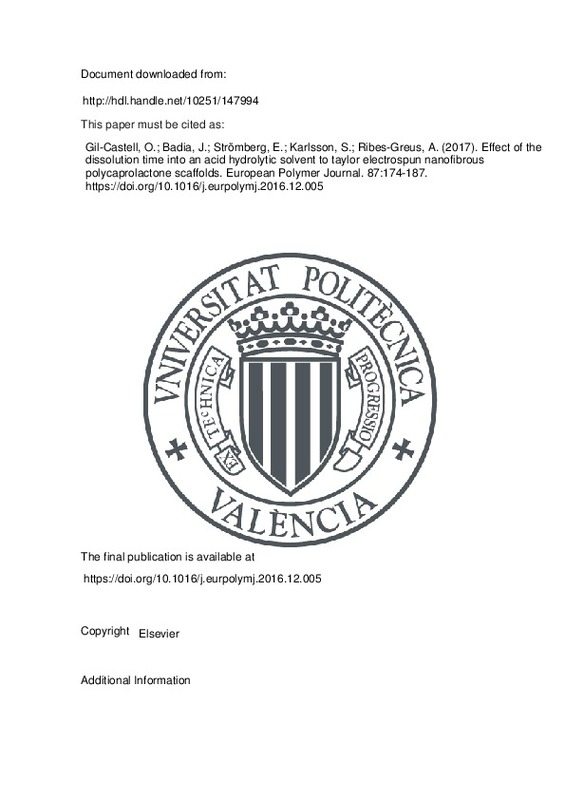JavaScript is disabled for your browser. Some features of this site may not work without it.
Buscar en RiuNet
Listar
Mi cuenta
Estadísticas
Ayuda RiuNet
Admin. UPV
Effect of the dissolution time into an acid hydrolytic solvent to taylor electrospun nanofibrous polycaprolactone scaffolds
Mostrar el registro sencillo del ítem
Ficheros en el ítem
| dc.contributor.author | Gil-Castell, O.
|
es_ES |
| dc.contributor.author | Badia, J.D.
|
es_ES |
| dc.contributor.author | Strömberg, E.
|
es_ES |
| dc.contributor.author | Karlsson, S.
|
es_ES |
| dc.contributor.author | Ribes-Greus, A.
|
es_ES |
| dc.date.accessioned | 2020-07-15T03:31:47Z | |
| dc.date.available | 2020-07-15T03:31:47Z | |
| dc.date.issued | 2017-02 | es_ES |
| dc.identifier.issn | 0014-3057 | es_ES |
| dc.identifier.uri | http://hdl.handle.net/10251/147994 | |
| dc.description.abstract | [EN] The hydrolysis of the polycaprolactone (PCL) as a function of the dissolution time in a formic/acetic acid mixture was considered as a method for tailoring the morphology of nanofibrous PCL scaffolds. Hence the aim of this research was to establish a correlation between the dissolution time of the polymer in the acid solvent with the physicochemical properties of the electrospun nanofibrous scaffolds and their further service life behaviour. The physico-chemical properties of the scaffolds were assessed in terms of fibre morphology molar mass and thermal behaviour. A reduction of the molar mass and the lamellar thickness as well as an increase of the crystallinity degree were observed as a function of dissolution time. Bead-free fibres were found after 24 and 48 h of dissolution time with similar diameter distributions. The decrease of the fibre diameter distributions along with the apparition of beads was especially significant for scaffolds prepared after 72 h and 120 h of dissolution time in the acid mixture. The service life of the obtained devices was evaluated by means of in vitro validation under abiotic physiological conditions. All the scaffolds maintained the nanofibrous structure after 100 days of immersion in water and PBS. The molar mass was barely affected and the crystallinity degree and the lamellar thickness increased along immersion preventing scaffolds from degradation. Scaffolds prepared after 24 h and 48 h kept their fibre diameters whereas those prepared after 72 h and 120 h showed a significant reduction. This PCL tailoring procedure to obtain scaffolds that maintain the nanoscaled structure after such long in vitro evaluation will bring new opportunities in the design of long-term biomedical patches. (C) 2016 Elsevier Ltd. All rights reserved. | es_ES |
| dc.description.sponsorship | The European Regional Development Funds and the Spanish Ministry of Economy and Competitiveness are acknowledged for the projects POLYCELL (ENE2014-53734-C2-1-R) and UPOV13-3E-1947. The Spanish Ministry of Education, Culture and Sports is thanked for the pre-doctoral FPU grant of O. Gil-Castell (FPU13/01916) and the scholarship for a research stage of 0. Gil-Castell in Kungliga Tekniska Hogskolan (KTH). Generalitat Valenciana is thanked for the APOSTD/2014/041 for J.D. Badia. Universitat de Valencia (UV) and HS LaFe are acknowledged for the DERMASAFE project. The financial support given by the ICTH Royal Institute of Technology and the Universitat Politecnica de Valencia (UPV) are gratefully acknowledged. IESMAT S.A. and Malvern Instruments Ltd are recognised for their grateful collaboration. | es_ES |
| dc.language | Inglés | es_ES |
| dc.publisher | Elsevier | es_ES |
| dc.relation.ispartof | European Polymer Journal | es_ES |
| dc.rights | Reserva de todos los derechos | es_ES |
| dc.subject | Electrospinning | es_ES |
| dc.subject | Scaffold | es_ES |
| dc.subject | Hydrolysis | es_ES |
| dc.subject | Polycaprolactone (PCL) | es_ES |
| dc.subject | In vitro validation | es_ES |
| dc.subject.classification | MAQUINAS Y MOTORES TERMICOS | es_ES |
| dc.subject.classification | CIENCIA DE LOS MATERIALES E INGENIERIA METALURGICA | es_ES |
| dc.title | Effect of the dissolution time into an acid hydrolytic solvent to taylor electrospun nanofibrous polycaprolactone scaffolds | es_ES |
| dc.type | Artículo | es_ES |
| dc.identifier.doi | 10.1016/j.eurpolymj.2016.12.005 | es_ES |
| dc.relation.projectID | info:eu-repo/grantAgreement/MECD//FPU13%2F01916/ES/FPU13%2F01916/ | es_ES |
| dc.relation.projectID | info:eu-repo/grantAgreement/MINECO//UPOV13-3E-1947/ES/Cromatrografía por Exclusión de Tamaños/ | es_ES |
| dc.relation.projectID | info:eu-repo/grantAgreement/MINECO//ENE2014-53734-C2-1-R/ES/DISEÑO Y VALIDACION DE MEMBRANAS CON CONTROL MORFOLOGICO PARA SU USO EN PILAS DE COMBUSTIBLE DE BAJA TEMPERATURA SOSTENIBLES EN VEHICULOS EFICIENTES NO TRIPULADOS/ | es_ES |
| dc.relation.projectID | info:eu-repo/grantAgreement/GVA//APOSTD%2F2014%2F041/ | es_ES |
| dc.rights.accessRights | Abierto | es_ES |
| dc.contributor.affiliation | Universitat Politècnica de València. Departamento de Máquinas y Motores Térmicos - Departament de Màquines i Motors Tèrmics | es_ES |
| dc.contributor.affiliation | Universitat Politècnica de València. Instituto de Tecnología de Materiales - Institut de Tecnologia de Materials | es_ES |
| dc.description.bibliographicCitation | Gil-Castell, O.; Badia, J.; Strömberg, E.; Karlsson, S.; Ribes-Greus, A. (2017). Effect of the dissolution time into an acid hydrolytic solvent to taylor electrospun nanofibrous polycaprolactone scaffolds. European Polymer Journal. 87:174-187. https://doi.org/10.1016/j.eurpolymj.2016.12.005 | es_ES |
| dc.description.accrualMethod | S | es_ES |
| dc.relation.publisherversion | https://doi.org/10.1016/j.eurpolymj.2016.12.005 | es_ES |
| dc.description.upvformatpinicio | 174 | es_ES |
| dc.description.upvformatpfin | 187 | es_ES |
| dc.type.version | info:eu-repo/semantics/publishedVersion | es_ES |
| dc.description.volume | 87 | es_ES |
| dc.relation.pasarela | S\325177 | es_ES |
| dc.contributor.funder | Generalitat Valenciana | es_ES |
| dc.contributor.funder | European Regional Development Fund | es_ES |
| dc.contributor.funder | Royal Institute of Technology, Suecia | es_ES |
| dc.contributor.funder | Universitat Politècnica de València | es_ES |
| dc.contributor.funder | Ministerio de Economía y Competitividad | es_ES |
| dc.contributor.funder | Ministerio de Educación, Cultura y Deporte | es_ES |







![[Cerrado]](/themes/UPV/images/candado.png)

